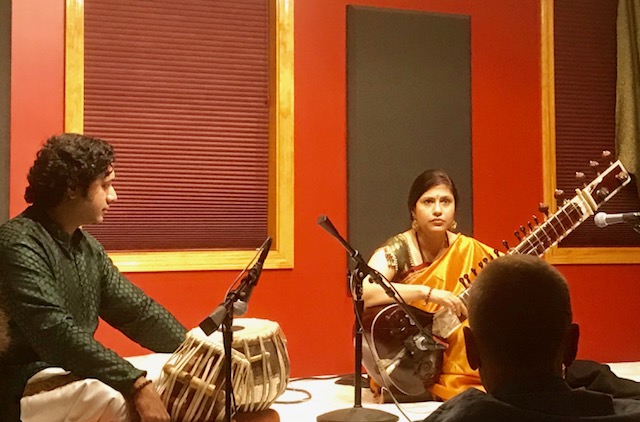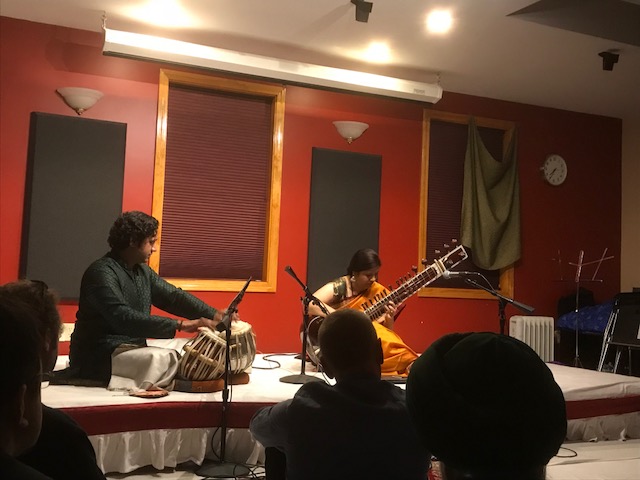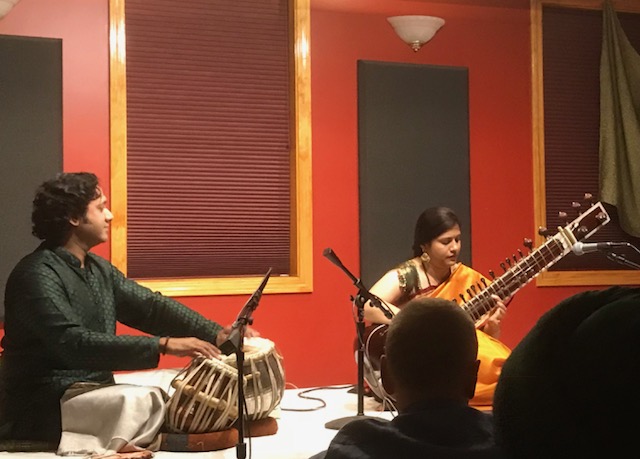Contribute
| Engaging Sitar Recital By Anupama Bhagwat |
Shuchita Rao
10/19/2017
As part of the ongoing 2017 Learnquest Baithak Hindustani classical music series, Smt. Anupama Bhagwat presented a sitar recital on Sunday, October 15, 2017. Smt. Bhagwat is a disciple of the renowned musician, the late Acharya Bimalendu Mukherjee, who was a musician of many talents. In addition to being a sitar player, he was a vocalist and percussionist who played a variety of string instruments such as RudraVeena, Saraswati Veena, Surbahar, Sursingar, Mandrabahar, Dilruba, Esraj and Sarod. Shri Mitta, a disciple of the eminent Pandit Arvind Mulgaonkar of the Faurukkhabad gharana has the distinction of accompanying the best known Hindustani musicians in the current times. There is something to be said about the atmosphere created by the rich sounds of a well-tuned sitar in a dimly lit, intimate baithak setting packed with music lovers and connoisseurs. It brings people of varied ethnic backgrounds together very quickly. Against a brilliant red backdrop sat Smt. Anupama Bhagwat holding the sitar, dressed in a traditional mustard kanjeevaram silk, projecting the beauty and the grace of the quintessential Indian woman. To her right sat Shri Nitin Mitta dressed in an emerald green silk kurta, carefully tuning his instrument to match the sitar’s tonic note with the calm confidence of a seasoned professional. As dusk slowly descended onto the autumn sky, Smt. Bhagwat introduced raga Patdeep’s descending notes in a pizzicato motion with the rapid plucking of multiple sitar strings. She presented alaap (meditative prelude), jor (metered alaap section) and a short jhaala for twenty minutes before proceeding to play a gat (composition) in slow tempo sixteen beat rhythm cycle teentaal. While the alaap was contemplative and replete with pensiveness, the composition was marked by the mature exploration of the raga in all three octaves and a rich variety of fluid fast taan movements ending at different notes of the raga’s scale such as the bottom kharaj, komal gandhaar and upper shadja . Smt. Bhagwat and Shri Mitta began a musical conversation with playful rhythmic exchanges from the very beginning, giving each other the necessary space to display technical prowess with their individual instruments. There was the trading of ideas in dynamic exchanges, expert modulation of tones and a coordinated closing musical statement by markedly slowing down the tempo. A short composition in Raga Kamod set to twelve beat rhythm cycle ektaal was the next offering. The character of the raga was established methodically with emphasis on the raga’s signature phrase “Re Pa Dha Pa Ga Ma Re Sa†as well as repeated zig-zag movements (vakra chalan). Tempo was increased during the rendition several times and fast-paced taans (which can be difficult to play due to the raga’s oblique movements) matched with nuanced percussive accompaniment, transported listeners to a world of ambient, organic sound. Post intermission, the main raga to be presented was Gaavati. Sensitivity to the intricacies of pitch and timbre, assertive melodic phrases, the coaxing of notes by pulling the strings in gliding motion and releasing them slowly in the alaap section was followed by driven, rhythmic passages in the gat (composition) section which was set to ten beat cycle jhaptaal. A faster tempo composition set to sixteen beat cycle teentaal ensued and Smt. Bhagwat’s presented several speedy taans in ascending and descending movements with flourish. What gave the composition in raga Tilak Kamod presented after raga Gaavati a distinctive flavor was the alternating play of two sixteen beat cycle variations, addha teentaal and regular teentaal in a single composition. The finale, a lilting thumri in Raga Mishra Pahadi set to eight beat cycle keherwa was light-hearted. The reaction of the audience attending the concert was overwhelmingly positive. Dr. Pradeep Shukla, founder of Learnquest congratulated the artists for a melodious performance in his closing remarks. Brian Wood, an artist who drove down to Framingham from upstate New York to attend the concert said “The music was sublime.†What I found particularly impressive about the concert was the attention given to planning in terms of the sequence of the ragas presented and the duration of each offering. While the weighty opening raga Patdeep rendition gave the listener a peak into the technical expertise of both artists, the featured piece post-intermission, raga Gaavati gave a fuller glimpse of Smt. Bhagwat and Shri Mitta’s strenghts. The Kamod, Tilak Kamod and Mishra Pahadi raga renditions were concise and sweet and much shorter in duration. The final musical presentation, the raga Pahadi thumri brought the fevered moments of passionate play in the earlier raga renditions to a gentle conclusion. The baithak concert was a delightful partnership between Smt. Bhagwat and Shri Mitta whose deep love for music and phenomenal talent came through loud and clear in the spirited raga renditions. Music is the vehicle of expressing emotions and this dynamic duo did well in giving the audience a memorable ride from a world of sweetness and sadness into a world of happiness and joy.
You may also access this article through our web-site http://www.lokvani.com/


